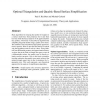Free Online Productivity Tools
i2Speak
i2Symbol
i2OCR
iTex2Img
iWeb2Print
iWeb2Shot
i2Type
iPdf2Split
iPdf2Merge
i2Bopomofo
i2Arabic
i2Style
i2Image
i2PDF
iLatex2Rtf
Sci2ools
COMGEO
1999
ACM
1999
ACM
Optimal triangulation and quadric-based surface simplification
Many algorithms for reducing the number of triangles in a surface model have been proposed, but to date there has been little theoretical analysis of the approximations they produce. Previously we described an algorithm that simplifies polygonal models using a quadric error metric. This method is fast and produces high quality approximations in practice. Here we provide some theory to explain why the algorithm works as well as it does. Using methods from differential geometry and approximation theory, we show that in the limit as triangle area goes to zero on a differentiable surface, the quadric error is directly related to surface curvature. Also, in this limit, a triangulation that minimizes the quadric error metric achieves the optimal triangle aspect ratio in that it minimizes the L2 geometric error. This work represents a new theoretical approach for the analysis of simplification algorithms.
| Added | 22 Dec 2010 |
| Updated | 22 Dec 2010 |
| Type | Journal |
| Year | 1999 |
| Where | COMGEO |
| Authors | Paul S. Heckbert, Michael Garland |
Comments (0)

